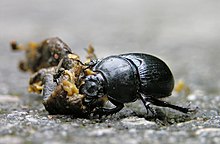Wood dung beetle
| Wood dung beetle | ||||||||||||
|---|---|---|---|---|---|---|---|---|---|---|---|---|

Wood dung beetle ( Anoplotrupes stercorosus ) |
||||||||||||
| Systematics | ||||||||||||
|
||||||||||||
| Scientific name | ||||||||||||
| Anoplotrupes stercorosus | ||||||||||||
| ( Scriba , 1791) |
The Forest dung beetle ( Anoplotrupes stercorosus ) is a beetle from the family of the dung beetle (Geotrupidae). It is a species that occurs frequently in the forest and is mostly native to beech forests throughout Germany and Europe .
features
The wood dung beetles are 12 to 19 mm long and therefore do not reach the length of the very similar common dung beetle . The beetles are black-blue, the wings on the sides are blue, violet or green, the pronotum is blue-violet in some animals. The underside of the body is metallic blue, purple or green, the antennae are red-brown. The base of the pronotum is completely rimmed and irregularly dotted. The end tooth of the anterior splint is slightly pointed, and the thighs of the forelegs have no tomentose mark on their front. The rear rails are also only provided with two cross bars. The cover wings have no seam and each have seven slightly dotted longitudinal grooves.
Occurrence
The animals occur in Europe , east to the west of Siberia , north to about the 67th parallel. They can be found from the lowlands to around 2,000 meters above sea level, especially in forests .
Way of life
The wood dung beetles feed on excrement, sometimes mushrooms and tree sap. In spring, males and females build a 70 to 80 mm deep tunnel in the ground, from which several side passages branch off, which end in chambers. The females do the underground work, the males the above-ground, e.g. B. the removal of the ejected earth. An egg is laid in each of the chambers and faeces are brought in, which the larvae feed on. These need a year to develop; they still overwinter as larvae and only pupate in spring. The beetles hatch in summer, but are not sexually mature until next spring.
Wood dung beetles are individually on the lookout for food, e.g. B. they are often seen on forest trails. When males and females who are ready to mate meet, the male teases the female with the maxillary palps , the tips of which are covered with sensory organs, while at the same time producing short advertising sounds. The female continues to run, the male follows and maintains physical contact. If this is lost, both animals generate search sounds that last up to 1.5 seconds. Eventually the female begins to bury herself. While digging in, the female emits sounds called guide sounds. Mating probably takes place in the underground passages.
The sound production of the dung beetles is easy to prove. If you hold a beetle to your ear, the protest sounds can be clearly heard. During the formation of the sounds, specialized parts of the skeleton are rubbed against each other ( stridulation ). The shrill strip ( pars stridens ) strokes the shrill edge ( plectrum ). Both males and females have sound mechanisms. It is unusual that every wood dung beetle has two differently built sound devices located in different parts of the body. According to the structures involved in sound formation, these are:
- The Coxo metasternal instrument, discovered as early as 1867. The shrill strip is on the rear coxa , the thickened edge of the III acts as a shrill edge. abdominal sternites . In the males the shrill ridge is 1.38 mm long, 0.39 mm wide and contains 87.44 ribs (mean values from at least 10 individual values), in the females the length is 1.48 mm, the width 0.37 mm, the Number of ribs 91.92.
- The abdomino-elytral instrument that was only detected in 1902. On the lateral edges of the III. abdominal sternites there is the pars stridens, which is formed as a 1.8 mm long and 0.45 mm wide field of hair that is rubbed against the plectrum, which is arranged on the underside of the cover wings and consists of strong scales.
When producing sound, the beetles can use both stridulation organs at the same time or at different times or only use one of the two.
Individual evidence
- ^ Zahradník, Jirí: Beetles of Central and Northern Europe . Ed .: Paul Parey. Paul Parey, Berlin / Hamburg, p. 144 .
- ↑ a b c Adelheid Winking-Nikolay : Investigations into the bio-acoustics of the wood dung beetle, Geotrupes stercorosus Scriba . In: Zeitschrift für Tierpsychologie , 37th Jg., No. 5, 1975, pp. 515-541.
- ↑ Hermann Landois : The sound and vocal apparatus of insects in anatomical-physiological and acoustic relationship . In: Journal for Scientific Zoology , 17th vol., 1867, pp. 105–186.
- ↑ KW Verhoeff: The composite chirping device from Geotrupes. Meeting reports of the Society of Friends of Natural Sciences in Berlin 1902, pp. 149–155.
literature
- Karl Wilhelm Harde, František Severa, Edwin Möhn: The Kosmos Käferführer: The Central European Beetles. Franckh-Kosmos Verlags-GmbH & Co, Stuttgart 2000, ISBN 3-440-06959-1 .
- Jiří Zahradník , Irmgard Jung, Dieter Jung et al .: Käfer of Central and Northwestern Europe , Parey Berlin 1985, ISBN 3-490-27118-1 .



